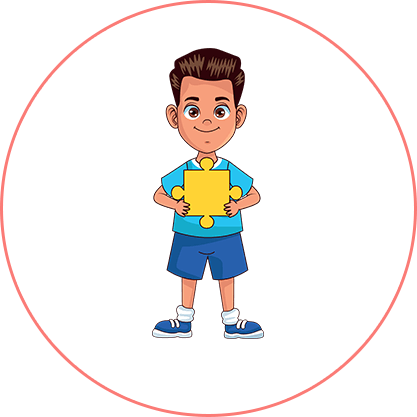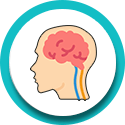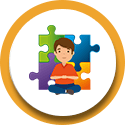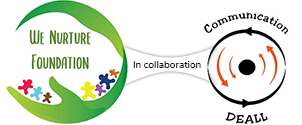Assessment
Why assessment is important
The ComDeall program reports a high success rate with children getting integrated into the mainstream with 1-2 years of intensive intervention therapy. The success rates are higher for children admitted at an early age, as young as three-years-old. That is not to suggest that older children do not see an improvement. They do, but after a longer duration of therapy. Hence, early detection assumes such a critical role.
A detailed assessment, on the other hand, is the key to early detection and intervention. It sets the tone for the road ahead.


For an intervention to be impactful, the approach needs to be an interdisciplinary one.

A detailed assessment is the key to early detection and intervention.

The success rates are higher for children who are admitted at a young age.
The nature of neurodevelopmental disorders is such that multiple areas of functioning are affected. A child with speech problems could have sensory issues such as poorly developed Oro-Motor skills or a child with hyperactive tendencies could have issues with the visual-auditory perception; the symptoms are a consequence of more than one unmet milestone skills. Therapy is, therefore, interdisciplinary. Treating each of the symptoms as a separate case will have no or limited outcomes. For an intervention to be impactful, the approach needs to be an interdisciplinary one. Which means, it should be a consolidated effort of all disciplines where several professionals like the speech pathologist, occupational therapist, and special educators collaborate towards ameliorating a particular developmental disorder.
An early detection rate of Autism Spectrum Disorders is low because even professionals sometimes recommend a "wait and watch" approach. Family history plays a role in when a skill might emerge. That's also a reason to delay diagnosis. Furthermore, the societal outlook has tarnished the image of clinical diagnosis. It is generally considered to be the last resort. Parents shy away from getting a diagnosis for fear of labelling the child. The apprehensions and challenges are compounded when they are not provided with a clear understanding of the diagnosis and are vaguely directed towards therapy clinics.
A detailed assessment, on the other hand, is the key to early detection and intervention. It sets the tone for the road ahead. Early and intensive intervention by qualified therapists for over a time is critical to seeing significant progress in the development trajectory of the child. An interdisciplinary approach—something that is missing across medical circles— saves caregivers considerable stress of finding individual therapists who may be spread across the city and managing their time around multiple therapies.
One of the primary goals of Comdeall@WeNurtureFoundation is to fill the void of an early intervention centre that takes care of all the therapeutic needs of the child under a single roof. Our team of speech pathologists, occupational therapists, and educators conduct a thorough analysis of the child's condition through observation of the child in a comfortable setting, discussions with the parents, and documenting our conclusions on a comprehensive and exhaustive checklist.
Read Less ↑How Comdeall@We Nurture Foundation conducts an assessment

We Nurture Foundation prepares detailed profiles for a child to assess various skills under each of the seven categories.

Developmental checklist
The developmental checklist is comprehensive and categorized into eight primary domains: receptive and expressive language, gross and fine motor skills, activities of daily living, cognitive, social and emotional skills. It also follows a developmental hierarchy from 0-72 months in 12 months at six months interval. The sub-grouping starts from 0-6, 6-12, 12-18, and so on until the child is six years of age. So, there are 12 sub-groups in all. Three questions are defined for every sub-group across the eight domains to assess age-appropriate skills within that age bracket and particular domain.
Response Sheet
The checklist carries a response sheet that assigns scores from 0-4 to cover the range of responses; zero for skills not acquired, 1 for skills that were acquired, but lost, 2 for emerging skills, 3 for skills that are acquired but not consistently present, 4 for skills acquired and present during all situations. Where the parent is unsure of the answer, it is marked as no response (NR). The final scoring and graph constitute a developmental profile of the child.

Developmental skills of a child are difficult to assess and observe because children generally behave differently around close family and when around strangers. For this purpose, the assessment by experts is carried out across multiple days and corroborated by parental observations. Any discrepancy between the two is reassessed and checked across domains to establish reliability.
Like the developmental profile, a thorough questionnaire-driven checklist is used to build the child's profiles for sensory skills, occupational skills, pre-requisite learning skills (PLS), oro-motor skills, and physical skills. We also carry out an in-depth behaviour analysis ABC for the child. The profiling takes into consideration the family's medical history, pre-and-post-natal journey, and parental observations.
Once the profiles for a child are ready, we chart the course of treatment. We help the child acquire the unmet milestone skills, as indicated by the profile chart, even though the child may have crossed the age when the skill is usually acquired. An unmet milestone is like a blank piece in a jigsaw. The skill itself might seem like a tiny aberration in the child's journey, yet in the larger scheme of things, that piece is crucial for other skills to emerge and help the child function as a whole.
It is important to note that the profile is a summary of observations and is not an estimate of the child's potential. It provides therapists with a guideline to enable the child to meet the age-appropriate skills.
After the initial assessment, we set target goals and domain-specific goals that help us reach the target goal, which is usually mainstream school readiness. Subsequent assessments over an academic year help us take stock of the progress and revisit the target goals, as the case may be.
Our approach requires all stakeholders—the child, the caregivers, and the therapists—to be on the same page during the entire course of therapy. Hence, we have periodic assessments, allow for two-way feedback, and revisit the target goals for the child as needed.
Read Less ↑






